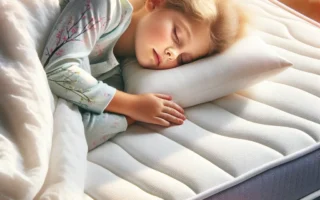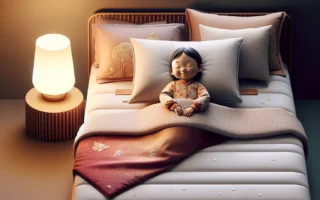Factors to Consider When Choosing a Mattress for Your Child
When it comes to choosing the best mattress for your child, there are several important factors to consider. Firstly, you’ll want to think about the size of the mattress. It’s essential to ensure that the mattress fits the bed frame and provides enough sleeping area for your child to move around comfortably. Additionally, consider the firmness of the mattress. While adults often prefer a firmer mattress for proper back support, children may benefit from a slightly softer mattress to accommodate their developing bodies.
Another important factor is the material of the mattress. Opt for hypoallergenic and breathable materials to ensure your child’s comfort and minimize the risk of allergic reactions. Furthermore, it’s crucial to consider the mattress’s durability. Look for mattresses that can withstand the inevitable jumping and roughhousing that often comes with kids.
Lastly, take into account any specific health considerations your child may have, such as allergies or asthma. In such cases, consulting with a healthcare professional for mattress recommendations can be beneficial. By carefully considering these factors, you can ensure that you choose the best mattress to support your child’s quality sleep and overall well-being.
Top 5 Mattress Options for Kids: Pros and Cons
When it comes to choosing the best mattress for kids, parents often find themselves overwhelmed by the numerous options available in the market. To make the selection process easier, here are the top 5 mattress options for kids along with their pros and cons.
1. Innerspring Mattress: This traditional type of mattress provides excellent support and is generally more affordable. However, it may not offer the same level of pressure relief as other options and can be noisy if not properly constructed.
2. Memory Foam Mattress: Known for its contouring properties, memory foam mattresses can alleviate discomfort and promote better sleep. On the downside, they may retain heat and emit a slight off-gassing odor initially.
3. Latex Mattress: Made from natural materials, latex mattresses are hypoallergenic and resistant to dust mites. Nevertheless, they tend to be on the pricier side and may not be suitable for kids with latex allergies.
4. Hybrid Mattress: Combining the support of innerspring with the comfort of foam, hybrid mattresses offer the best of both worlds. Yet, they can be heavier and more expensive than other options.
5. Adjustable Air Mattress: With customizable firmness settings, air mattresses allow for individualized comfort. However, they are susceptible to punctures and may require more maintenance.
When deciding on the right mattress for your child, it’s essential to consider factors such as their sleeping preferences, any specific health concerns, and your budget. By weighing the pros and cons of each mattress type, you can make an informed choice that contributes to your child’s optimal sleep quality.
The Importance of Support and Comfort in Children’s Mattresses
When it comes to choosing the best mattress for kids, it is crucial to prioritize the importance of support and comfort. As children are in the crucial stages of growth and development, a mattress that offers proper support is essential for their overall well-being. A supportive mattress helps to ensure that children maintain a healthy posture during sleep and provides the necessary foundation for their growing bodies.
Equally important is the comfort aspect of a child’s mattress. Comfortable bedding promotes better sleep quality, which is vital for children’s physical and mental development. A mattress that is too firm can create pressure points, leading to discomfort and disturbed sleep, while a mattress that is too soft may not provide adequate support. Finding the right balance of support and comfort is key to ensuring that children get the restorative sleep they need.
When shopping for a children’s mattress, look for options that offer both sufficient support and cushioning comfort. Consider factors such as the mattress’s firmness, materials used, and overall construction. Additionally, take into account your child’s individual needs and preferences, such as any specific health considerations or sleep habits.
By prioritizing support and comfort in choosing a mattress for your child, you can help set the foundation for healthy sleep habits and proper growth and development.
Tips for Maintaining Your Child’s Mattress for Longevity
When it comes to choosing the best mattress for kids, parents often focus on factors like comfort, support, and durability. However, once the perfect mattress is selected and in use, it’s equally important to maintain it properly to ensure its longevity. Here are some essential tips for maintaining your child’s mattress to keep it in top condition for years to come.
- Use a Mattress Protector: Investing in a high-quality mattress protector is an effective way to safeguard the mattress from spills, stains, and odors. This waterproof barrier can significantly extend the life of the mattress.
- Rotate the Mattress: To promote even wear and prevent sagging, it’s recommended to rotate the mattress every few months. This simple practice can help maintain its shape and support.
- Ensure Proper Support: Placing the mattress on a sturdy bed frame or foundation is crucial for ensuring proper support. Check the bed frame regularly to make sure it’s in good condition and capable of supporting the mattress effectively.
- Keep It Clean: Regularly vacuuming the mattress and airing it out can help eliminate dust, debris, and moisture, thus preventing the accumulation of allergens and odors.
- Follow Manufacturer’s Guidelines: Always review the manufacturer’s care instructions for the specific mattress. Adhering to their guidelines for cleaning and maintenance can help preserve the mattress’s warranty and overall quality.
By following these tips for maintaining your child’s mattress, you can protect your investment and ensure that your child enjoys a comfortable and supportive sleep environment for years to come.



